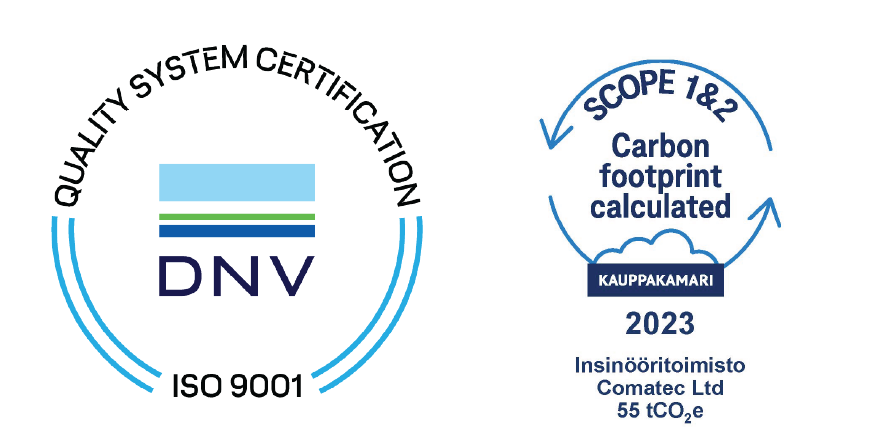
E2 challenges leading brands’ electric motorcycles
This article may contain outdated information.
When Teemu Juvakka answered a questionnaire about the stress calculation of motorcycle frames, he had no idea what he was getting into. A few years later, a company was formed around this cooperation. It is developing a Finnish serially manufactured electric motorcycle, and the first motorcycles are estimated to reach buyers, ready to ride, in the beginning of 2020.
From concept to production in less than two years
The father of the idea is Teemu Saukkio, whose original goal was to fulfil a challenge thrown his way and build a self-made electric motorcycle. At this point, Teemu Juvakka’s help was needed to calculate and model these ambitious ideas into a feasible product. The first self-made version, E1, was built as a hobby and presented at the Motorcycle show in 2018. The concept attracted a lot of attention, and both the development of the product and the business surrounding it have leapt forward in a short time. Several dozen pre-orders are waiting.
Right now, they are working on the bike’s next phase, E2. The aim is to get plates for the prototype and test drive it in the spring of 2019. The production of a small series of the bikes should start at the end of 2019, and the first deliveries should hopefully happen at the start of 2020.
The Finnish challenger is entering intense markets where leading brands already have their electric bikes. As far as we know, Harley Davidson’s LiveWire will be launched in August, but its capacity is much smaller than the E2’s. In addition to its Finnish design, the E2 challenges well-known competitors with the great efficiency of its motor.
Almost 100 % self-made design
According to Teemu Juvakka, the E2 is a fair-priced, serially manufactured electric motorcycle that represents the best Finnish expertise, innovative solutions and modern standards and production methods, and is truly “Made in Finland”.
One of the main properties of the model being developed right now is a technically sophisticated motor solution, with the motor integrated into the back rim. This allows building the motorcycle without any mechanical power transmission from body to back yoke. This way, the finished bike has fewer parts, requiring less maintenance from the customer.
“We also don’t want the customer to pay an arm and a leg for Finland’s first electric bike. Instead, we want both to be a pioneering company and cover the costs. For this reason, we have designed almost everything in the bike ourselves.”
When the goal is an almost completely self-made product, there are also challenges ahead. Teemu Juvakka doesn’t admit to encountering major troubles during the design phase, but the back yoke’s structure and body have caused some challenges.
“We haven’t used commercial bearings, but instead, designed them ourselves. We plan to keep developing the yoke and remain at the leading edge of technology,” Juvakka concludes.
“Another challenging area has been the body.” The concept planner and designer create a certain shape, and the mechanics must be built according to that shape. Getting them to match has required a little more work.
The aim is to start small series production during the latter half of the year. Until then, they will focus on eliminating small faults that have come up. Next on Teemu Juvakka’s list is the placement of electronic parts into the body. He needs to solve how the parts will be arranged and how the cables should be routed into the body.
Comatec behind the back yoke’s mechanical design
Even though the aim is to keep the designing work inside the company, the most urgent phases have required outside help.
“In the summer of 2018, the situation got a little tough, when all kinds of things had to be planned in a very short time. At this point, we turned to Comatec for help in designing the back yoke. In practice, we needed the model and drawings in less than a month. It’s a tough spot for any engineering company, but we got results as agreed,” Teemu Juvakka says.
At Comatec, the need was addressed in the midst of the hottest summer period.
“The customer gave us a 3D model, created by the designer. We needed to use that as a housing-like, bendable and weldable back yoke structure and create part and manufacturing drawings for building a prototype,” describes Engineering Manager Raine Corell.
“It was challenging to determine how all the edges could be bent, where the welding seams should be placed, and what parts should be used to assemble the structure. We were, however, able to deliver both the 3D models and drawings to our new customer in less than a month from the order. In my opinion, this is proof of our flexibility and service-minded attitude.
The back yoke is also on our list for further development. Next we need to figure out how to make the back yoke lighter and still keep the structure strong enough,” Juvakka concludes.
WHAT IS THE E2
The first Finnish electric motorcycle
Power: 50 kW
Torque: 320 Nm
Top speed: 160 km/h
Range: 200-300 km
Charging type and time: Type II plug at the front of the saddle. The charging time is estimated to be around 2 – 3 hours with one phase and 1 – 3 hours with three phases. The aim is also to achieve a quick charging function of 15 – 30 minutes.
Price: 24 900 €
Company: RMK Vehicles Corporation Oy
TEKSTI: MARIA UURTO
KUVAT: RMK VEHICLE CORPORATION OY



